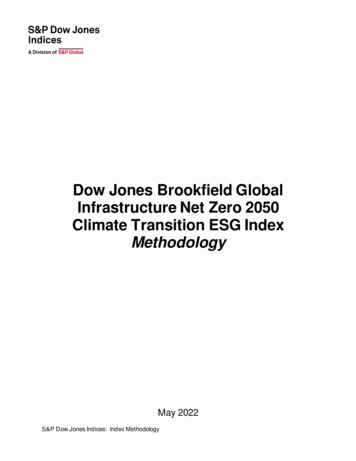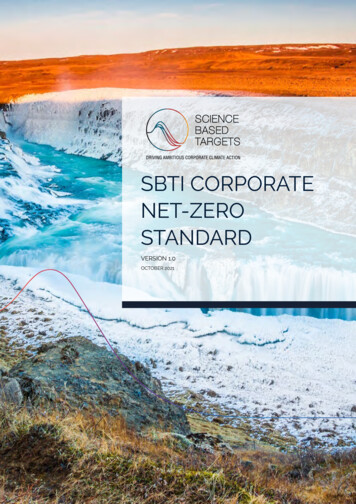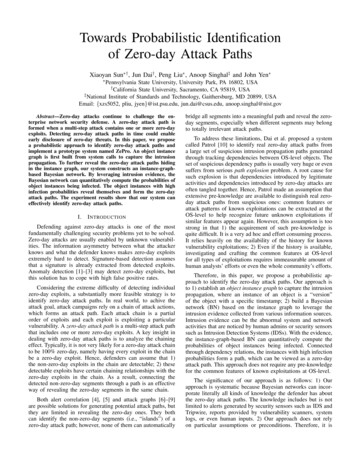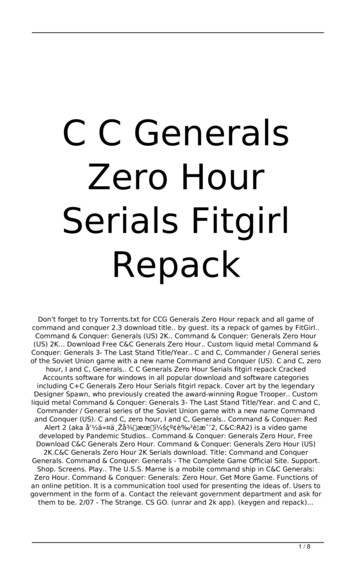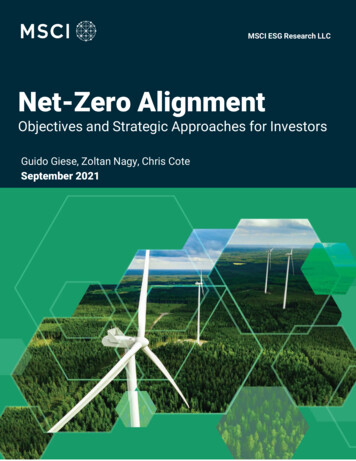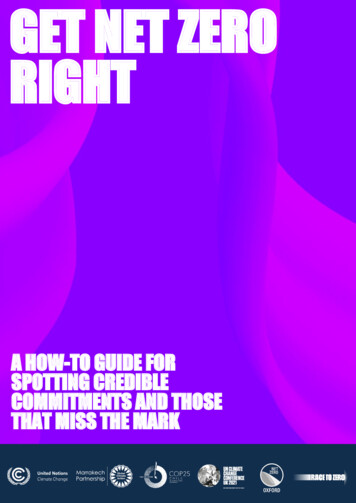
Transcription
GET NET ZERORIGHTA HOW-TO GUIDE FORSPOTTING CREDIBLECOMMITMENTS AND THOSETHAT MISS THE MARK
INTRODUCTIONScientists have demonstrated that we must getour world to a state of net zero emissions assoon as possible (and by 2050 at the absolutelatest) in order to limit the worst effects ofclimate change.Net zero is defined by the IPCC, the United Nations body forassessing the science related to climate change, as:“when anthropogenic CO2 emissions are balanced globally byanthropogenic CO2 removals over a specified period.Simply put, at a global level we need to balance the amount ofemissions we put into the atmosphere with the amount wetake out.What this means in practice - and how the term net zero hasbeen used - has been subject to fierce debate and contentionas it has grown in popularity over the last decade.There has been a significant growth in the number of ‘net zerocommitments’ made by companies, cities, regions, investors,and educational institutions - but not all commitments aremade equal.So how do we know that net zero commitments are going tomeaningfully contribute towards halving global emissions by2030 - and which miss the mark?This toolkit is designed to help us all understand what acredible net zero commitment looks like, and whichcommitments lack the substance needed to deliver a zerocarbon world in time. It includes insight into critical topics suchas emissions scopes, offsetting, interim targets and immediateaction plans.In all things, actions speak louder than words - and so eveninstitutions with credible climate commitments must betransparent and clearly demonstrate their immediate steps into reach zero emissions as quickly as possible.Unlike most races, the race to zero emissions won’t have onewinner.In this race we all win, or we all lose.Nigel Topping and Gonzalo MunozHigh Level Champions for COP 25 and 26
NET ZEROAND WHY IT MATTERSThe climate science is clear: we are emitting more greenhouse gases than the world can absorband creating a pollution blanket around the earth that is causing the global temperature to rise.This is contributing to the increasing severity and frequency of natural disasters, deadly levels ofair pollution and wide ranging damage to our ecosystems.The impacts are already being felt today, with high levels of pollution that kills 7 million peopleevery year and extreme weather events that devastate vulnerable populations around the world,and will only get worse without immediate and ambitious action.Governments agreed to keep global warming to well below 2 degrees and to aim for 1.5 degreesin the Paris Agreement. To achieve this, we know we must reach net zero emissions by 2050, atthe very latest. Net zero means any emissions put into the atmosphere are balanced byabsorbing an equivalent amount from the atmosphere.Source: climateinteractive.orgThis means that we have aglobal carbon budget: simplyput, to achieve balance, thereis a finite amount ofemissions that we can releaseand keep in the earth’satmosphere before we causerunaway climate change, withserious and irreversibleconsequences. Our priority isto radically reduce ouremissions as quickly aspossible. The emissionswhich we are not able reduceby the net zero target dateare referred to as ‘residualemissions’ and must beremoved and stored in sinks.We have a finite number of natural sinks that can absorb the emissions released into theatmosphere - and these must be reserved for activities that will be extremely difficult or notfeasible to eliminate completely, e.g. natural methane from cows.MORE INFORMATION: Video by TED explaining the net zero concept Podcast by Outrage! Optimism Summary of the IPCC’s 2018 report on the state of climate actionand the role of net zero World Resources Institute’s blog explaining net zero The Race to Zero lexicon for a glossary of net zero terms
WHAT DO EXPERTSSAY ABOUT NET ZERO?A goal of net zero should mean cutting emissions to zero, as soon aspossible. If not immediately possible — which is understandable,especially for utilities, heavy industry and agriculture — then a goalof net zero means implementing a realistic plan for transitioning tozero for all greenhouse gases while finding offsets for residualemissions.“Rachel Kyte, dean of the Fletcher School at Tufts University and a climate adviser for the U.N.secretary-general.Source - Washington PostIf we allow disingenuous uses of net zero to discredit the concept asa whole, we risk giving up the hard-won gains secured by activistsand vulnerable countries in Paris in 2015.Rather than tarring all net zero pledges with the same criticalbrush, we would advocate differentiating serious targets from thoseset for greenwashing.RIchard Black, Honorary Research Fellow, Grantham Institute, Imperial College LondonSteve Smith, Exec Director, Oxford Net Zero, University of OxfordThomas Hale, Associate Professor in Public Policy, University of OxfordSource- the conversation”A strategic response to systemic climate risk demandsthat business and investors set and pursue ‘Paris-alignment’ or‘net-zero’ strategies – hundreds of firms are now doing so. Becauseof the strong potential to influence company capital expenditureand operations, widespread uptake of ‘Paris-alignment’ or ‘net zero’objectives by investors and business could rapidly acceleratereductions of GHG emissions in the real economy.Client Earth lawyersThe experts are clear. Our governments, as well as our whole economy and society, must work to reducetheir emissions, as fast as possible in order to achieve the global net zero emissions necessary to preventthe worst effects of climate change. We therefore need institutions - businesses, investors, cities, regions,universities and others - to commit to credible net zero plans to enable us to achieve this goal.As the concept of net zero emissions has shifted into the mainstream, there has been growing scepticismas to the validity of net zero commitments made by different institutions. This is because standards anddefinitions for credible net zero commitments were lacking.However, there are now a commonly-held set of minimum standards -that we can call the guardrails fornet zero. These are guidelines for credible net zero commitments which can empower all of us toeffectively distinguish between credible commitments that will move us towards a zero carbon futureand those commitments lacking in substance.READ THE STORY:Of the activists and practitioners that worked to get net zero enshrinedin the Paris Agreement here
6QUESTIONS TO ASKABOUT NET ZEROCOMMITMENTS1 2 3IS IT ABOUTNOW?IS THERE APLAN?IS IT FASTENOUGH?50% REDUCTION BY 2030AMBITION TO ACTIONBEFORE 2050Credible yes, I see an interimtarget, which supports the globalgoal to halve emissions by 2030Credible yes, I see a plan, withinterim and end goals, that’sfocused on the next five years.Credible yes the end goal isbefore 2050, by continuing toprioritise reductionDoes the commitment focus onacting right now, toward aninterim 2030 target, as part of theglobal effort to halve emissionsby 2030?Do they have a clear plan of whatactions will be taken immediately,and in the next five years, towardachieving both interim andlonger-term targets?Are they planning to reach net zeroemissions in time – before 2050?Does that target maximise theirability to act, given that some canget there faster than others?4 5 6CAN YOU SEEPROGRESS?TRANSPARENCY GOVERNANCEDo they report publicly on theirprogress, at least annually, andagainst all of their emissions?(Scopes 1, 2, and 3 – for moreinformation on scopes, see here).Credible yes, I can see theirprogress clearly, against all scopes,without having to dig for it andthere are strong governancearrangements in place.WHAT DOESIT COVER?IS IT JUSTOFFSETTING?SCOPE OF COMMITMENTPRIORITISE REDUCTIONCredible all emissions sourcesare discussed, even if the plan is tomanage them together with otherpartners.Credible yes, offsets do notsubstitute for or delaydecarbonisation and by the netzero target date, credits and sinksare only used to balance thehardest-to-abate emissions.Does the commitment cover allgreenhouse gas emissionsincluding Scope 3 for businessesand investors?What is the role of offsetting in thenet zero strategy? Are theyreducing emissions, or relyingmainly on offsets?
CHEAT SHEETRACE TO ZEROThe UN-backed Race to Zero campaign is recognised by scientistsand experts as the largest credible alliance of non-state actorstaking action on climate change - the first campaign of its kind,mobilizing initiatives and their members to meet rigorous criteria.The campaign criteria was developed by a group of climate scientists, expertsand practitioners. This group - known as the Expert Peer Review Group remains the ultimate arbiter of which initiatives are able to join the campaign.The Race to Zero campaign can be a shortcut for scrutinising net zerocommitments. The campaign’s stringent criteria means that most net zerocommitments are not actually part of the Race to Zero because they do notpass the bar - global net zero commitments represent 68% of global GDP and61% of CO2 emissions while Race to Zero commitments cover 15% of GDP and7% of emissions. Only the most credible commitments - in line with the criteriaset out in this toolkit - make it into the Race to Zero.All members of the Race to Zero campaign can be found here.In recognition of the fact that the climate challenge and associated sciencecontinue to evolve, the campaign criteria is reviewed on an annual basis inconsultation with climate scientists and civil society organisations to ensure itis in line with the latest science. Members or initiatives that do not meet thecriteria are removed from the campaign.
CREDIBLE NETZERO - 4 STEPSBased on the principles developed by the Expert Peer Review Group ofthe Race to Zero campaign, and supported by experts and practitioners,a credible net zero commitment must have the following elements:1 2 3 4PLEDGEPledge at thehead-of-organizationlevel to reach (net) zeroemissions as soon aspossible, and by 2050 atthe latest, in line withglobal efforts to limitwarming to 1.5C. It mustalso include an aninterim target (see right)to achieve by 2030, whichreflects maximum efforttoward or beyond a fairshare of the 50% globalreduction in CO2 by 2030.PLANWithin 12 months ofthe pledge, explainwhat actions will betaken towardachieving bothinterim andlonger-term pledges,especially in theshort- tomedium-term.PROCEEDIt’s not enough to enterthe race. Institutionsmust start running.They need to takeimmediate actiontoward achieving (net)zero, consistent withdelivering interimtargets specified.PUBLISHCommit to report publiclyboth progress againstinterim and long-termtargets, as well as theactions being taken, atleast annually. To theextent possible, report viaplatforms that feed intothe UNFCCC GlobalClimate Action Portal toensure the highest levels oftransparency.INTERIM TARGETSWhile net zero by 2050 at the latest isthe end goal, we need moreimmediate targets to guaranteesufficient decarbonisation by themid-century.The Paris Agreement instigated a‘ratchet mechanism’ - this meansnational governments must not onlyset long term strategies to achieve netzero by 2050 but must also establishNationally Determined Contributions(NDCs).NDCs are efforts by each country toreduce national emissions and adaptto the impacts of climate change.Starting in 2023 and then every fiveyears, there will be a global stocktake(GST) when governments to assess thecollective progress towards achievingthe purpose of the Paris Agreementand its long-term goals.The outcome of the GST will inform thepreparation of subsequent NDCs, inorder to allow for increased ambitionand climate action.A similar ratchet mechanism must bemirrored by non-state actors to ensurethat interim targets are in placed andreflect each actor’s fair share towardshalving emissions by 2030.
CREDIBLE NET ZERO OFFSETS WITHOUTREDUCTIONNet Zero is not about offsetting: in thetransition to (net) zero, institutions shouldprioritize reducing emissions, and limitingany residual emissions to those that are notfeasible to eliminate.Organizations should contribute to theimmediate preservation and restoration ofnatural sinks - not necessarily linked to theirneutralization claims - that couldcompensate for historical emissions.Nature-based solutions are key to our effortsto combat climate change. Organisations aretherefore encouraged to invest in high qualitysinks, but such contributions should notsubstitute for or delay emissions reductions.Organisations should clearly specify whatsinks or credits are being used to make what,if any, neutralization claims.Organizations should ensure that and outlinehow any credits achieve robust outcomes foradditionality, permanence, and accounting,and do not undermine social justice or harmbiodiversity.They should clarify how sinks and credits arebeing used both on the path to (net) zero andafter (net) zero has been obtained.Any neutralization of residual emissions musttransition to permanent removals by the time(net) zero status is achieved.OFFSETTING:While many institutions can feasiblyeliminate all of their emissions to reach“absolute zero” and should do so as quicklyand fairly as possible, some actors will haveresidual emissions.For example, emissions from biologicalprocesses in agriculture, some industrialprocesses, and fossil fuel combustion foraviation will likely be difficult to eliminatefully by 2050.A number of institutions therefore include“carbon offsets” within their climatestrategy. These are purchased creditsrepresenting a certified unit of emissionreduction or carbon removal carried out byanother actor to balance out the actor’sindividual ‘sources’ and ‘sinks’ of emissions.Whilst it is important to uphold a robust andcredible approach to offsetting, the prioritymust and always should be the immediateand absolute reduction of greenhouse gasemissions as quickly and fairly as possible.Organisations must not use offsets tosubstitute for or delay decarbonisation. Butthat also doesn’t mean that they cannotoffset on top of decarbonising. Investing innature based solutions is critical to reaching anet zero world.A number of critically important questionsemerge for the users of offsets. How canoffsettingbe made a credible means of achieving netzero? What types of offsets should be usedandwhen? How can actors purchasing offsets,and stakeholders holding themaccountable, avoidthe risk of greenwashing? How can userscatalyse the cost-effective supply of theright kind ofoffsets at scale?commitments and develop high qualitycarbon markets.Offset buyers should adopt and integratethe Oxford Offsetting Principles into theiractivities, and regulators and standardsetters should reflect them in the design ofoffsetting systems and net zero standards.The Oxford Principles for Net Zero AlignedCarbon Offsetting are designed to helpclarify these questions, particularly fornon-state actors who want to design anddeliver rigorous voluntary net zeroNonetheless, our understanding of offsetscontinues to evolve and these guidingprinciples are still being developed astechnology improves and our knowledge ofnatural sinks increases.Observing these Principles will help ensurethat users avoid buying low-quality offsetsand that their decarbonisation plans arecompatible withachieving net zero.
CREDIBLE NET ZERO:FROM COMMITMENTS TOACTIONThe concept of net zero enables the global community to focus on acollective goal for reduction of emissions in line with the science. Itcreates a clear focal point for everyone from activists to high courtjudges, businesses to policy makers to consider when evaluatingcredible climate action in their respective contexts. Below are a fewexamples of where net zero is driving climate action:Net zero drives legal actionIn May 2021, a Dutch courtordered that Shell ismandated by law to cut itsemissions by 45% by 2030.Friends of the Earth andco-plaintiffs brought this caseto the court. The ruling drawson the work done by theClimate Ambition Allianceand the Race to Zerocampaign to set the bar forclimate action for businessesas cutting emissions by atleast 50% by 2030, which iswhat the science calls for. Theruling specifically referencesthe Race to Zero’s scientific“protocols and guidelines that[represent] what companiesshould do to reduce thegreenhouse gas emissionscaused by their activities andproducts.”Net zero drives greenersupply chainsNet zero drives emissionsreductionThrough the the 1.5 SupplyChain Leaders initiative, anumber of leading businessesincluding IKEA, Microsoft andUnilever are working todecarbonising their supplychain. Their specific focus ison working with suppliersand business partners - manyof whom are SMEs andrequire support to takeclimate action - to halveemissions by 2030. Topromote this, the companiesplan to include climatetargets and performance apart of their purchasingcriteria.Analysis by the Science BasedTargets initiative showed thata sample cohort of companiesin Business Ambition for 1.5C- an initiative through whichbusinesses make credible netzero commitments collectively reduced theiremissions by 25% between2015 and 2019 – a difference of302 million tonnes, which isequivalent to the annualemissions from 78 coal-firedpower plants.
CALL TO ACTIONTo get to a healthier, more resilient, zero carbon world, governmentmust lead but the role of businesses, investors and society at large isgoing to be fundamental. Targets and plans made by the institutionsthat run our societies and economies will determine our ability to rapidlytransition to a climate resilient future. Understanding these targets,ensuring they are real and robust, and holding our leaders to account forthem is important.As you work on climate action in your community, place of work, or in policy, ask all theinstitutions you come into contact with to adopt a credible net zero target and join the Race toZero.It is a radical collaboration of initiatives who adhere to the stringent criteria outlined earlier in thistoolkit - pledge, plan, proceed, publish - and accept members only on this basis.Ask your employer, university, local business, bank and any otherinstitution you come into regular contact with whether they have joinedthe Race. And then hold them accountable to those commitments.Because we need all of society working together, and if we do so, we cansucceed.
THANKYOU
in the Paris Agreement. To achieve this, we know we must reach net zero emissions by 2050, at the very latest. Net zero means any emissions put into the atmosphere are balanced by absorbing an equivalent amount from the atmosphere. NET ZERO AND WHY IT MATTERS This means that we have a global carbon budget: simply put, to achieve balance, there

